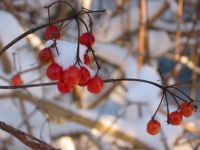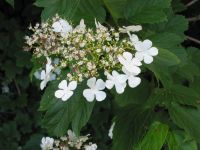Sargent viburnum - Viburnum opulus var. sargentii
English name:
Sargent viburnum
Scientific name:
Viburnum opulus var. sargentii
Family:
Adoxaceae (Adoxa family)
Height:
up to 4 m.
Flowering:
early to mid June
Range:
Manchuria, Russian Far East, Korea, Japan
 |
|
 |
 |
The 37-year-old Viburnum opulus var. sargentii in the picture can be found near the edge of the first grass and near the main Arboretum road: square 1115 position 3932.
Plant description:
With so many plants to look after and so many other duties, I dont have many chances to study any one species or variety (taxa) in much detail. However, writing the plant of the month also gives me a nice excuse to study one taxa in a bit more detail. This allows me to learn something new and sometimes can correct problems or confusing entries in our electronic register (database). Such is the case with this months plant Viburnum opulus var. sargentii which up to now has been registered under three different names; as the name given above, as Viburnum opulus var. calvescens, and as V. sargenti (or V. sargentii). Now all the plants are registered under one name, V. opulus var. sergentii. Unfortunately the other names will remain on the plant tags for some months. We are systematically changing all of the tags in our collection. So changes will have to wait until we get to the areas where the plants are located.
The genus Viburnum comprises about 150 species (3 in Europe). Members of this genus are small trees or shrubs with opposite leaves that can be deciduous or evergreen. Some are used as medicinal plants and the wood has been used to make arrows. Now the genus is mostly known for its ornamental garden plants. The Hørsholm Arboretum collection contains 28 different Viburnum species or about 19% of all known species. We have 9 specimens of V. opulus var. sargentii. Our wild collected specimens come from Japan, Russia and South Korea. The oldest wild collected plant in the Arboretum was collected during the Nordic Arboretum Councils expedition to Korea in 1976.
Viburnum opulus var. sargentii was perhaps first introduced into Denmark in 1935 by the nurseryman Aksel Olsen in Kolding. Our oldest specimen was received from Aksel Olsen in 1951 and may well be related to or a cutting from this first introduction.
V. opulus var. sargentii becomes a large deciduous bush with tan branches. The leaves are typically 3 lobed but are occasionally 5 lobed. Leaf margins are toothed, and the petioles have two large glands at the base. The fertile flowers are bisexual and occur in the middle of flattish upright, inflorescences. Showy, white, sterile flowers occur at the edges of these inflorescences to attract pollinators. The fruits are shinny-red, translucent, and last until January. The purple anthers of this variety sargentii help to distinguish it from other varieties.
Viburnum opulus var. sargentii forms a large bush with delightful flowers and attractive, long-lasting, fruit for early winter colour. A named cultivar (V. sargentii Onondaga) is good enough to have a place in the book Plants that Merit Attention II. Shrubs. Several other named cultivars exist including one with yellow fruit and anthers. The best fruit development occurs in sunny positions, although the plants survive well in the shade of our birch collection.
References:
Cullen, J. et al. (eds.) 2000. The European Garden Flora Vol VI. Loganiaceae to Compositae. Cambridge University Press. 739 pp.
Lange, J. 1994. Kulturplanternes Indførselshistorie i Danmark. (Introduction History of Cultivated Plants in Denmark). Jordbrugsforlaget, Frederiksberg. 458 pp.
Mabberley, D.J. 1998. The Plant Book. 2nd edition. Cambridge University Press, Cambridge, 858 pp.
Ohwi, J. 1984. Flora of Japan (in English) Smithsonian Institution, Washington D.C., 1067 pp.
Olsen, O. et al. 1997 Havens Planteleksikon. Træer og Buske. (Danish Plant Encyclopedia, Trees & Bushes). Det Danske Haveselskab Publisher, 674 pp.
Poor, J.M. & Brewster, N.P. 1996. Plants that merit attention. II. Shrubs. Timber Press Inc. Portland.
